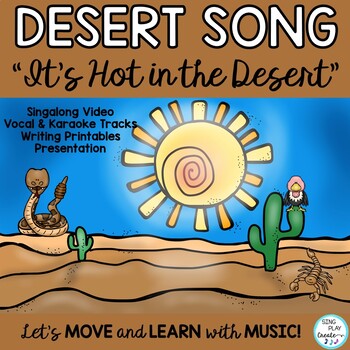Desert Habitat SingAlong Video Song Writing Activities “It’s Hot in the Desert”
- Zip
Description
Distance learning Sing along Video and Music Tracks
Sing this desert song with your students to learn about habitats. Desert science habitat and literacy lessons are so easy when students sing, read and write about the desert. Rockin' upbeat song with vocal and karaoke tracks, "It's Hot in the Desert". Perfect for Music and Science in First, Second and Third grade Habitat lessons and Music programs.
PREVIEW INCLUDES VIDEO AND AUDIO SAMPLE
RESOURCE INCLUDES:
Sing Along Video
Power Point presentation with lyrics
Storybook pages
Mp3 Tracks Vocal and Accompaniment
Hand Actions
Science Standards Connections
Writing Activities-
Printable Lyric Sheet students can color
Writing Activity
USE THIS RESOURCE:
HOME SCHOOL
DISTANCE LEARNING
ELA ACTIVITIES
SCIENCE ACTIVITIES
SUMMER CAMPS
INTEGRATED ARTS AND CURRICULUM LESSONS
- The video makes it easy to use during your morning meetings, brain break time and reward activities.
- Combine the song and writing activities with your existing habitat lesson materials.
- Perfect for Pre-K, Kindergarten, First, Second and Third grade Habitat lessons.
- Music Teachers! Add this song to your desert and western music programs.
- Grab the attention of your students by using this song in your science lessons while studying habitats.
- Why not sing the song during your morning meetings and then later during science students will reflect on the song and connect to their lessons even better!
- Use the video in your homeschooling or distance learning classes.
Your students will love learning about desert habitats when they get to sing too!
MUSIC TEACHERS:
Try integrating Science and Music together by using this song in your classroom or in a music program. Combine these Desert Songs with some of your favorite folk songs about animals in their habitats like:
Over in the Meadow
Gallump Went the Little Green Frog
Mr. Frog on a Log
Frog in the Millpond
Grizzly Bear
Black Snake
Mr. Rabbit
Here Goes the Red Bird
MORE HABITAT SCIENCE ACTIVITIES AND SONGS
Desert Habitat Song “Coyote, Coyote”
Desert Habitat Song “It’s Hot in the Desert”
Desert Habitat Song “Saguaro Cactus”
***********************
ABOUT SING PLAY CREATE LLC.
All products and works are copyrighted by Sing Play Create LLC. Buyers may get Free store credit by going to "my purchases" and click on "Provide Feedback". Ratings and helpful feedback are welcomed.
Want a Freebie every month? Subscribe to my Website Newsletter.
QUESTIONS? Please use the "Ask a Question" section of my TpT store. Or, you can email me at sandra@singplaycreate.com
CONNECT WITH ME HERE:
Sing Play Create YouTube Channel
Thanks for stopping by!
Sandra





